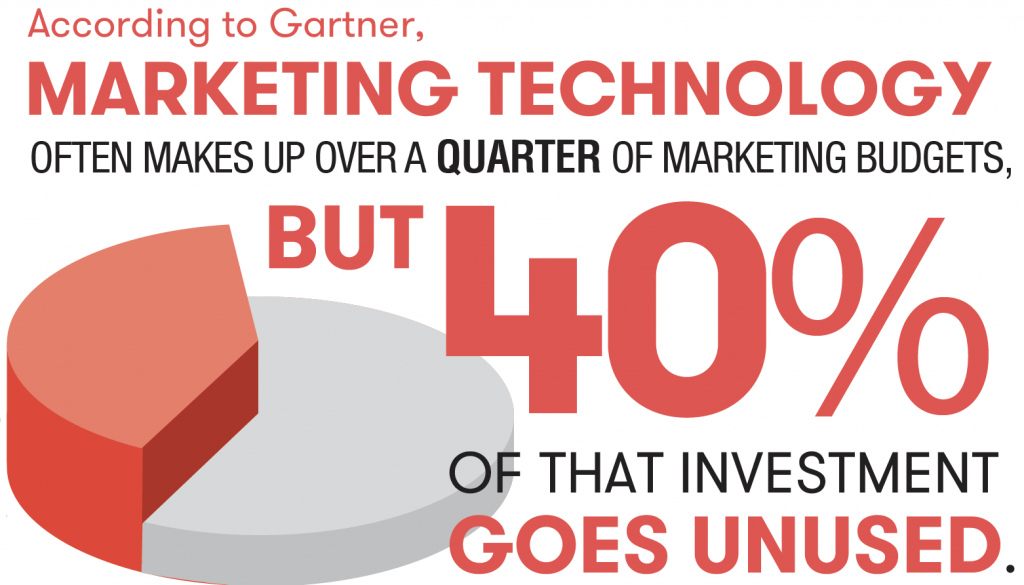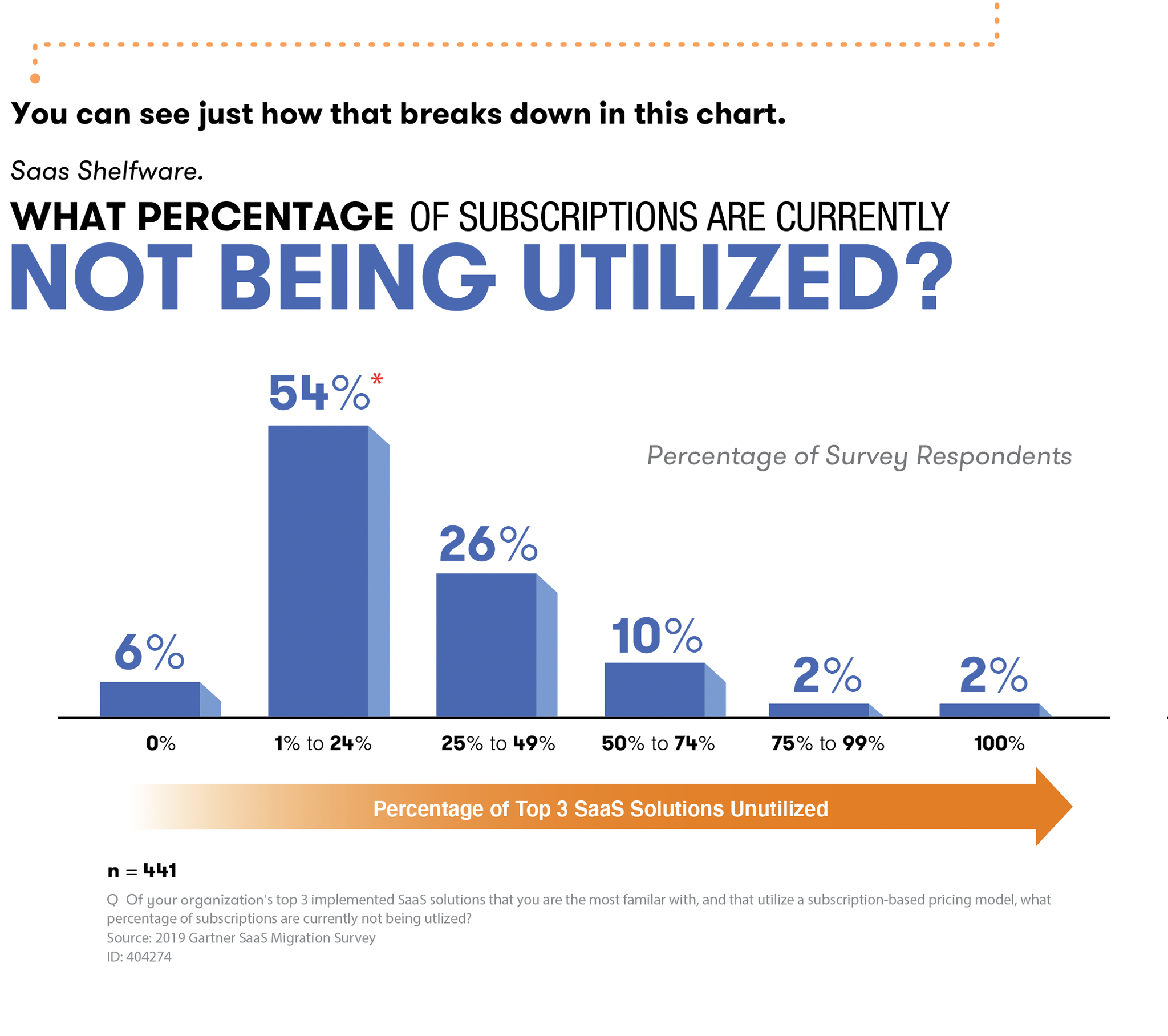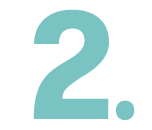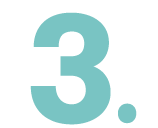Get What You Pay For:
The cost of Software Underutilization
Get the Whitepaper
There is no easy way to say this:..
You’re likely overpaying and underusing millions of dollars worth of software that your company purchased. Now that the hard part is out of the way, let’s break down what that means, how it happened and what to do about it.
We’re not just saying this based on a hunch – there are documented stats about this rampant, but often unknown, phenomenon.


Underusing software isn’t the only issue either, many times
companies will INVEST IN TWO PRODUCTS
THAT ESSENTIALLY DO THE SAME THING.
This can happen for many reasons, but oftentimes it comes down to either a lack of knowledge about what current tools are capable of or a lack of communication across teams and departments.
How much money does that come out to? How much lost productivity does that mean? The exact answers to those questions will vary company to company, but there are some basic figures. Companies with revenues between $50 million and $2 billion spend around $13,100 per employee on IT. Large companies with revenue above $2 billion spend around $11, 580 per employee. Smaller companies could end up spending even more, percentage wise, per employee.
So how do businesses get in these situations?
THERE ARE SEVERAL WAYS:

NEW SOFTWARE THAT OFFERS TO LET YOU BE “ON THE GROUND FLOOR”
Good news, there’s a great new software in your industry that will revolutionize a pain point for your sector! It’s innovative and shiny and you can be the first to use it. Oftentimes in these situations, companies will offer you steep discounts or appealing contracts to get you to sign up. Sometimes, this can work out great if the tool is as good as it says and stays on top of updates and industry shifts. Unfortunately that doesn’t always happen, and many new tools don’t live up to the hype or you don’t need them nearly as much as you thought you did. Great in theory, but in practice they’re never quite what you’re hoping for.

DISCOUNT PACKAGES
You see it all the time – an expensive software has multiple tiers of buy-in. You can only afford the entry or mid level, but the salesperson is able to strike a deal where you get access to some of the higher level features for a slightly increased price or a longer contract. Contracts are signed, you get your software…and then you don’t use those fancy features that were negotiated into it.

BOUGHT FOR A PREVIOUS PROJECT
Sometimes you have a big need during a certain assignment or long-term project. Eventually, that project ends…and you forget to cancel the software licenses, reallocate them, or ensure future usage.

A-LA-CARTE FEATURES AND FUNCTIONS
A software seems cheap at the initial point of purchase, but then once you’re in you have to pay separately for each feature or upgrade. It’s easy in these situations to do these “one-off” costs, but over time those add-ons add up.

AUTOMATICALLY RENEWING CONTRACTS
While not as easy to slip into as some of the other ways this can happen, automatically renewing contracts are definitely a culprit of overspending on software. This can be particularly insidious if the contracts being renewed are for lower cost items that escape the notice of larger budgetary conversations.

THE SKILLS TO USE THE TOOLS
Sometimes the issue isn’t how software was purchased, it could simply be employees not knowing how to get the most out of it. This can be remedied by bringing in an independent third party who can audit your tech stack and help teach employees how to effectively get the most out of it.
Now that we know how this common issue happens…
WHAT CAN WE DO ABOUT IT?
The first step to solving this problem is understanding to what extent it affects you. As with all things, the best way to do this is with accurate, clean data. If you aren’t already tracking software usage in an efficient and understandable way, this will be the first thing you need to do. Once you’ve gotten your tracking down, find your baseline. Then you can use that to add KPIs and goals around software consumption. Examples of these goals include aiming to use a certain percentage of features, onboarding a certain number of employees, or hitting a specific cost-per-employee.
Beyond just including it in your KPIs, your success will also depend on making sure your entire team is on the same page. It will be difficult to enact solutions if some stakeholders believe one thing while others believe something entirely different. There needs to be a shared vision and a shared agreement on the acceptable costs and usage of your software stack.

Once you have your data all together and your team aligned…
YOU CAN MOVE ON TO THESE SOLUTIONS:

MAXIMIZE WHAT YOU ALREADY HAVE
This is a fairly simple solution – audit all the features and services available to you in your software. Once you understand everything you have access to, you can then figure out where you aren’t getting the most value. Perhaps there are features included that could serve the business but haven’t been properly utilized. Or perhaps employees weren’t properly trained on the capabilities of certain software, so they’re only getting minimal usage. Make sure you know what you have, your people know what they have, and that there is buy-in across the company to maximize your licenses and subscriptions.

REMOVE LICENSES AND FEATURES OR RE-HARVEST
An easy way to cut costs is to cut back on what you’re using in the first place. Oftentimes when we buy a new software, we might end up purchasing more features or licenses than needed. If you’ve already maximized what you have and have found out that there are things you will likely never use, see if you can get the cost reduced by removing those features. If you signed up for ten licenses but only five people use the software and the other five never will, see about cutting those licenses down. And if you can’t do that, re-harvest the licenses you do have. Re-harvesting is simple – it’s the process of removing licenses from those that aren’t using them and reallocating them to people that will. While re-harvesting won’t save you money immediately, it will at least make sure you’re getting your money’s worth.

LOOK FOR NEW USES
If you’re stuck in a contract, it can be difficult to simply cut back. If that’s not an option, consider find new uses for what you’re already paying for. Can you leverage your tools for clients to get them to cover some of the cost? Are there other departments who may find this software helpful? Are there new services that can be offered by your company using this software?
Entropy of the Martech stack is often the result of spot solutioning as above and the absence of a clear roadmap for optimal personalized customer experience delivery. Overpaying for tools is bad enough on its own, but the worst impact of getting to this state is that your organization is likely not effectively utilizing any one tool. Your company might be underdelivering experience to customers and underutilizing the data you have access to. In short, you could end up paying much more and achieving much less.
Software underutilization can be an expensive oversight, but it doesn’t have to stay that way. As long as you implement a thorough process for auditing and purchasing software as well as having company-wide alignment, you can avoid this problem.
AND IF YOU WANT TO EMBARK ON THIS
JOURNEY BUT NEED A LITTLE HELP,
JUST GIVE US A SHOUT.
"*" indicates required fields

